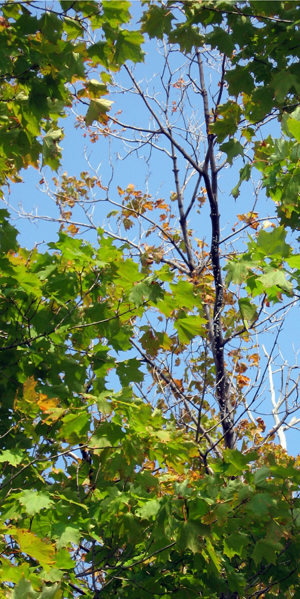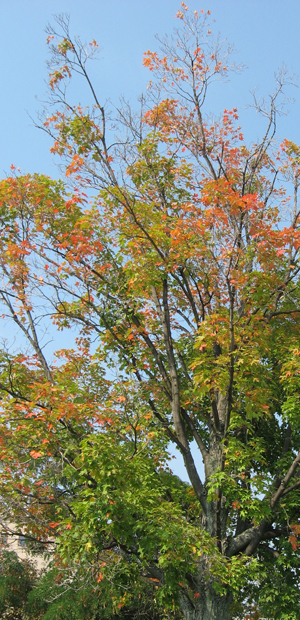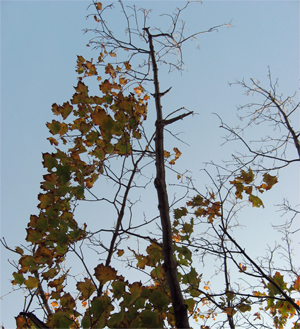Under the Scope Feature
Verticillium Wilt of Maple
June 2013
Be sure to submit the best possible tissue sample for the most accurate results.
Maple trees in landscapes may suffer from a wide variety of pest problems, but one of the more common requests for samples coming through the Clinic is for analysis for Verticillium Wilt. Although many hardwood tree species may be infected by Verticillium, some trees may tolerate infection better than others. Unfortunately, maple trees seem to be particularly susceptible. An additional issue, Maple Decline may be due to various factors, but it can be also confused with Verticillium Wilt. While decline may develop after a combination of adverse events, such as several successive years of defoliation by insects, severe drought, mechanical damage to the root collar, etc., Verticillium spp. may infect otherwise healthy trees. Replanting maple or other highly susceptible species in an area where Verticillium Wilt has previously occurred is not advisable so it's important to determine if a tree is infected.
When submitting samples for analysis for Verticillium, please keep in mind the following:
• The fungus may not be systemic throughout the entire infected tree so an asymptomatic branch may not have the fungus present in the small branches that are often collected and submitted for analysis.
 |
 |
 |
• Isolation from fresh, symptomatic living branch tissue is not difficult, but we have never successfully isolated this fungus from maple branches that exhibited no symptoms. Be sure to submit the best possible tissue sample for the most accurate results.
• A symptomatic branch may not only have unusually small leaves or exhibit premature fall color, but when the bark is peeled back from the infected maple branch, there is often some evidence of an olive-green discoloration or streaking of the sapwood. If the olive green discoloration is not evident, isolating from that tissue is not likely to be useful. On other hosts, this symptom may not be present, but look for it when collecting samples from maple trees for analysis.
• In New York and surrounding states, testing maple tissue for the presence of Verticillium from mid-summer through about mid-September is recommended. At that time, infected tissue may not only exhibit the symptoms that make it easier to select the best tissue for testing, but infected branch tissue may still be alive making it easier to isolate the fungus. Once an infected branch has died, secondary decay organisms may invade the tissue; such organisms readily out-compete Verticillium in culture and may prevent an accurate diagnosis.
So remember, if you think a tree may be infected and you want it tested, submit good quality tissue as soon as symptoms are noted. Don’t wait months and don’t wait until the branch dies, and please don’t collect a sample and leave it in a car, on a desk, in a garage, or anywhere else for days, weeks or even months before sending it in. Remember, a negative result from a poor quality sample only shows we could not isolate the fungus from that tissue, it does not indicate that the tree is not infected.
The Clinic also has fact sheets on other issues that may be helpful if you wish to learn more about other problems on maple. Please see our fact sheets on Maple Decline and Anthracnose of Trees for more information. You may also find Physiological Leaf Scorch, Cultural Tree Problems and Cankers on Trees to be informative.
Learn More
CU-PPDC News Feed
Diagnostic review reports and the latest lab updates delivered directly to you. Learn how!
